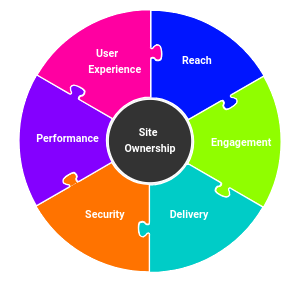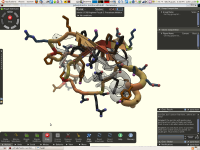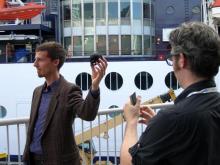
What do Twitter, cancer, interviewing movie stars, bike culture, and instant salt & pepper shaker manufacturing have in common? They were all represented on stage at GnomeDex 9 last Friday, a blogging conference on the waterfront in downtown Seattle. Several hundred thinkers, writers, inventors, and other interesting people from all over the country converged for a couple days of sharing their ideas and projects with each other and making new human connections.
After hearing good things about the conference for several years, this year I decided to check it out. We had other plans for Saturday, so I just went to the Friday sessions. Here are my highlights.
Least expected/coolest thing: Fold-It
I went to GnomeDex to hear some particular people speak, and hopefully meet them in person. I had never heard of Fold-It, but it was the most intriguing thing I saw at the conference. 
The cutting edge of Bio-Technology is centered around creating drugs to repair genetic defects. These work by targeting "broken" protein sequences, as I understand it (I'm definitely no expert in this area). But the first step in creating a cure is understanding what's wrong at a molecular level. That's where protein folding comes in. Protein molecules are crazily complex. There are some 20 standard amino acids that are part of different protein molecules, and together they build a complex shape of spirals, bands, side branches, receptors, hydrogen bonds, and other structures. These structures can be measured, modeled, and compared to synthesized proteins--but due to the extreme amount of variables involved in building protein structures, the biggest supercomputers in the world aren't capable of calculating how these structures get "folded" into the exact structure of even some of the more simple proteins.
Through a project called "Rosetta@Home" and another called "Folding@Home" you can put your spare computing cycles to work calculating protein structures and helping scientists learn how to change proteins that cause diseases like cancer, Huntington's Disease, Alzheimer's and other diseases with a potentially genetic cause. These programs crunch all the possible permutations of a small chunk of data, looking for arrangements of protein structures that match what scientists have observed in real life. And they show the models they're manipulating on your home computer's screen as a screensaver.
Some Rosetta@Home users watched enough of the protein folding on their computers to start to recognize what the computer should do to make the pattern more correct--and got a little frustrated that they couldn't steer the action in the right direction.
That's where Firas Khatib and a group at the University of Washington stepped in. With the help of the computer science department, they created a tool that allows you to drag, wiggle, and shape protein molecules, to bring them closer to known protein structures and to create entirely new proteins. And with a stroke of genius, they turned it into a multi-player game.
Now you can join a team of other players and try to rack up high scores, all by solving scientific puzzles. Now game players everywhere can say they're not slacking off, they're helping cure cancer!
Most emotional session: Drew's Cancer
Drew Olanoff ( @drew ) got diagnosed with Hodgkin's Lymphoma earlier this year. On the stage last Friday, he talked about his experiences learning how to use social media effectively in the past few years, and then after the diagnosis, apply it for his own benefit. He created a site called Blame Drew's Cancer, and has invited anybody to blame anything at all on his cancer. Why? "Because you have to beat up on cancer to win... and you can help!" Any tweet tagged with #blamedrewscancer causes a little sign to pop up on the site, where everyone can see it.
Drew's attitude was compelling. The talk was funny, sad, angry, and loving. At one point he invited audience members who had been diagnosed with cancer to come up on the stage, and gave them a hug. There wasn't a dry eye in the room. And he's got everyone in his corner, in the fight with him.
Skeptics and Bad Astronomy
Phil Plait ( @badastronomer ) blogs for Discover magazine as the Bad Astronomer. His mission: to teach people critical thinking. Seeing his name on the schedule was one reason I chose to attend. He gave an entertaining talk about skepticism in light of the seeming rise of outright lies. His main point: don't trust anybody without looking at the evidence yourself. The most skeptical show on television? MythBusters, of course.
Phil's talk was an entertaining survey of fallacies of the anti-vaccination crowd, global warming denyers, and the rise of pseudo-skeptics who ignore tested and confirmed results while claiming there is not enough evidence.
Perhaps the most entertaining part of the whole skeptical talk was it being followed by a talk on using pills for life extension...
3-D printing with the Makerbot
I knew this one would be cool. Bre Pettis ( @bre ) has made a machine that makes things. All kinds of things. As long as you have a 3-D representation of it, his machine can extrude plastic in a process he calls "3-D printing."
 Dominic Muren is an industrial designer and college professor, and he had gotten an MRI of his skull some time ago. After cleaning it up in a CAD program, he was able to upload it into Bre's MakerBot, and 20 minutes later, out came a miniature copy of it. See Bre's picture of it here.
Dominic Muren is an industrial designer and college professor, and he had gotten an MRI of his skull some time ago. After cleaning it up in a CAD program, he was able to upload it into Bre's MakerBot, and 20 minutes later, out came a miniature copy of it. See Bre's picture of it here.
Bre imagines that in a decade or so there will be a 3-D printer on everybody's desk. He envisions a day when you don't have to go to the store to buy stuff--you just get a design and print it for yourself. He showed a video of a couple of designers who created, designed, and architected the plans for a salt and pepper shaker, and with one visit to the MakerBot, their vision became a physical reality in less than an hour. Next up: 3-D scanners that make Star Trek's replicator a reality.
It's all about people
The best part of GnomeDex, like most of my favorite conferences, are the people you get to meet, the stories you get to share, and the ideas and passions that drive them forward. I talked for quite a whlie with Dominic about the sustainability of the MakerBot -- or lack of it. Would you really want to eat something created out of ABS plastic? His view: clearly not. We need to find ways of manufacturing things in a more sustainable way, and Dominic is exploring ways of creating things while paying attention to their entire lifecycle, from starting materials through to waste--and how to reuse that waste to minimize it. You can read more at his blog, Humblefacture. And stay tuned--we're planning to interview him for our podcast.
I got to talk with a lot of great people at the event, lunch, dinner, and party afterwards. Liz Strauss ( @lizstrauss, http://successful-blog.com ) told me the story of how she got into social media strategy, after being a text book editor and school teacher. Much of what she learned teaching in the classroom 25 years ago applies to blogging and social networking today--her stories of the classroom and publishing environment had us laughing. Mark Madsen ( @markmadsen, http://thirdnature.net/ ) and I discussed data visualization tools, and the inverted bell curve of open source adoption -- small companies use it, big companies use it, but the vast middle market does not. Opportunity? Certainly smells like it.
That just scratches the surface of my day at GnomeDex. Ignite talks, interviewing tips from Warren Etheridge, FileMaker Pro discussions, the Geek's Guide to Seattle, lots more. If you're at all interested in this stuff, be sure to go next August!

Add new comment